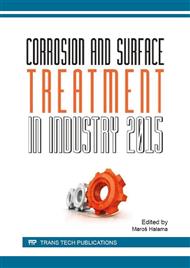p.50
p.55
p.59
p.65
p.75
p.79
p.83
p.89
p.97
Prediction of Materials and Coating Durability Based on Atmospheric and Laboratoty Tests
Abstract:
All industries are interesting in the durability/service life of products, structures, equipment, plants, etc. One factor affecting this is corrosion resistance. There are many methods for received such data. Methods supporting standardized data are long-term atmospheric corrosion tests, mapping of corrosivity, field tests on real structures including the evaluation of long-term exposed materials and coatings. The choice of suitable accelerated test is very important for receiving the reasonable information.
Info:
Periodical:
Pages:
75-78
Citation:
Online since:
March 2016
Price:
Сopyright:
© 2016 Trans Tech Publications Ltd. All Rights Reserved
Share:
Citation:


